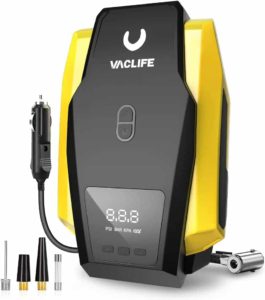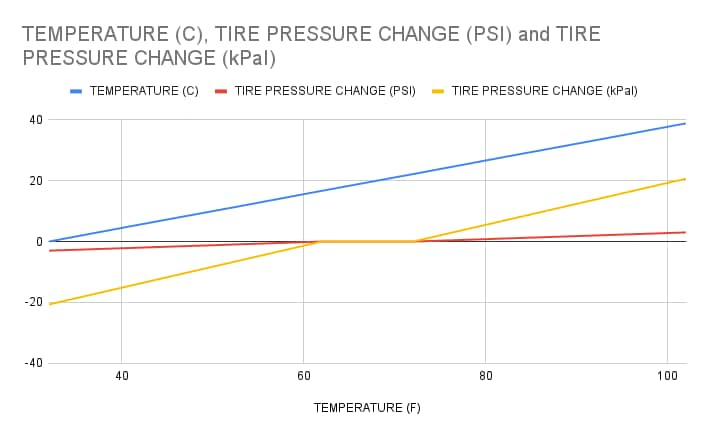Steps to Reset Hyundai Palisade Tire Pressure Light
Step 1: Check and Adjust Your Hyundai Palisade Tire Pressure
The Hyundai Palisade doesn’t have a tire pressure reset button to turn off the tire light. To turn off the tire light, make sure all four tires have the exact right amount of air. To find the right pressure, check the sticker inside the driver’s side door, look at the chart below, or use the Mode button on your steering wheel to see the tire pressure screen. Only adjust your tire pressure when your tires are cold.
2023 Hyundai Palisade Tire Pressure
Match your tire size to the chart below:
Tire Size | FRONT PSI | REAR PSI |
245/60 R18 | 35 | 35 |
245/50 R20 | 35 | 35 |
SPARE TIRE | 60 | 60 |
Step 2: Drive Your Palisade
After putting the right amount of air in your tires when they’re cold, it’s time to drive your Palisade. Drive for a few minutes going faster than 20 mph. You might see a message that says “drive to display.” Keep driving, and the tire pressure light should go off. If it stays on, just drive a little longer.
Step 3: Re-Check Your Tire Pressure
If the tire pressure light is still on after doing steps 1 and 2, check your tire pressure again to make sure it’s still at the right level. If it’s not, there could be some kind of air leak. If the tire light goes off after adding air but comes back on later, you definitely have a tire leak. If the tire pressure light blinks or flashes before staying on, it means you have a malfunction in your tire pressure monitoring system.
Hyundai Palisade TPMS Malfunction Indicator
The Hyundai Palisade has a tire pressure monitoring system (TPMS) malfunction indicator to let you know if there is a problem with the system. This warning uses the same yellow exclamation point light as the low-pressure warning. If there’s an issue with the TPMS, the yellow light will flash for about a minute before staying on. This flashing will happen every time you start your car until the issue is fixed.
It’s important to know that when this warning is on, the TPMS might not work right. Your tire pressure monitoring system won’t work as it should until the TPMS problem is fixed. So, if the tire pressure light is blinking, it means there’s a problem with the TPMS itself, like a faulty pressure sensor, not an issue with the air pressure in your tires. To figure out which tire sensor isn’t working, you’ll need to scan each sensor with a TPMS diagnostic tool. I use this Autel TPMS diagnostic tool.
When Should You Reset Your TPMS?
After inflating tires to the correct pressure: Reset the tire pressure light once you’ve filled all your tires to the recommended levels.
Following a tire rotation: Reset the light after your tires have been rotated to ensure the TPMS reads the new positions accurately.
After replacing a tire: If you’ve replaced a tire, make sure to reset the light so the TPMS can monitor the new tire properly.
When a TPMS sensor is changed or serviced: Reset the light after any TPMS sensor maintenance or replacement to ensure accurate monitoring.
After installing new wheels or changing tire sizes: If you’ve changed your wheels or tire sizes, reset the light so the TPMS can adjust to the new measurements.
After disconnecting or replacing your car battery: Reset the tire pressure light if your car’s battery has been disconnected or replaced, as the system may need to recalibrate.
When the TPMS malfunction indicator is activated: Reset the light if the TPMS malfunction indicator is on to ensure proper tire pressure monitoring once the issue is resolved.
During seasonal temperature changes: Reset the light when temperatures shift significantly, as changes in temperature can affect tire pressure.
How Does the Hyundai Palisade TPMS Work?
The purpose of the Hyundai Palisade TPMS is to keep you aware of the air pressure in your tires, which plays a significant role in the safety, handling, and fuel efficiency of your vehicle.
Tire sensors: At the core of the TPMS are the individual sensors placed inside each tire. These sensors are integrated into the valve stem inside of the wheel. They are designed to measure the air pressure inside the tire. The sensors are battery-powered, and their batteries have a lifespan of 5-10 years.
Data transmission: The tire sensors communicate wirelessly with the vehicle’s computer, also known as the Engine Control Module (ECM) or the Tire Pressure Monitoring System Control Module (TPMSCM). The sensors send real-time tire pressure data to the computer, ensuring the system is monitoring the current pressure levels.
Recommended tire pressure: The Hyundai Palisade has a specified recommended tire pressure level for each tire. In this case it’s 35 Psi. The vehicle’s computer keeps these recommended values in memory for comparison with the data received from the tire sensors.
Analyzing the data: The onboard computer constantly analyzes the data received from the tire sensors. It checks whether the current tire pressure levels are within the acceptable range based on the recommended 35 Psi. If the pressure in any tire falls below the minimum threshold, the computer will trigger the tire alert.
Dashboard warning light: If the computer detects low tire pressure, it activates a yellow warning light on the dashboard. This light resembles an exclamation point inside a tire and serves as a visual indicator that one or more tires need attention. You should take action to inflate the tires to their recommended levels as soon as possible.
What Causes the TPMS Light to Turn On?
The TPMS light in the Hyundai Palisade can turn on for different reasons, indicating possible problems that require attention. Here’s a list of these causes:
Low tire pressure: The most common cause for the TPMS light to turn on is when one or more tires have pressure below the recommended level. This can result from a slow leak, puncture, or natural pressure loss over time.
TPMS malfunction: If the TPMS itself is experiencing a problem, the warning light will flash for about a minute and then stay lit. This could be due to a faulty sensor, a dead or dying sensor battery, or communication issues between the sensor and the vehicle’s computer.
Seasonal changes: Fluctuations in temperature can cause changes in tire pressure. Cold weather often leads to a decrease in tire pressure, while warmer temperatures can result in increased pressure. The TPMS light will come on when significant pressure changes occur due to seasonal temperature shifts.
Tire rotation or replacement: The TPMS light might come on after a tire rotation or replacement if the system needs to be reset to the new tire positions.
New wheel or tire size installation: If you have installed new wheels or changed tire sizes, the TPMS light could come on if the system has not been recalibrated to account for the changes. This will also be a problem if you replace a wheel/rim and don’t swap sensors over from the old wheel to the new wheel.
Disconnected or replaced vehicle battery: The TPMS light might be triggered if the vehicle’s battery has been disconnected or replaced.
Sensor damage: Physical damage to a TPMS sensor, such as from an impact, corrosion, or improper installation, can cause the TPMS light to come on. I’ve seen many times the rubber gasket between the valve and sensor go bad, causing a leak at the valve. The rubber gasket is replaceable without having to replace the entire sensor using a kit like this.
How Does the Weather Affect Tire Pressure?
The graph displayed demonstrates the relationship between air temperature and tire pressure. It shows that as the temperature outside drops, tire pressure typically decreases, and conversely, as it gets warmer, tire pressure increases. So, with every 10-degree decrease in air temperature, your tire pressure will reduce by approximately 1 PSI.
The Benefits of Hyundai Palisade TPMS
The Hyundai Palisade TPMS offers numerous advantages to ensure your vehicle’s safety and performance. Here’s a quick rundown of the key benefits:
Enhanced safety: The TPMS constantly monitors tire pressure, alerting you of any significant changes. This helps prevent blowouts and accidents due to underinflated tires.
Better fuel efficiency: Properly inflated tires lead to improved fuel economy, saving you money at the gas pump.
Prolonged tire life: Maintaining optimal tire pressure extends tire lifespan, saving you money on replacements.
Optimal performance: With correctly inflated tires, your Palisade will handle better and provide a smoother, more comfortable ride.
Environmentally friendly: Increased fuel efficiency and reduced tire wear contribute to a lower carbon footprint.
Please note that this blog post contains Amazon affiliate links. This means that if you make a purchase through one of these links, we at TPMSRESET.com may earn a small commission at no extra cost to you. We only recommend products that we personally use and believe in. Thank you for supporting us.





